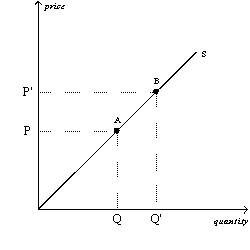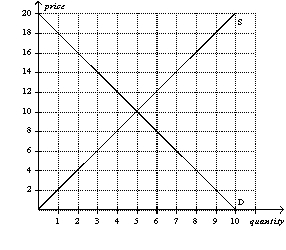A) demand is measured along the vertical axis,and price is measured along the horizontal axis.
B) quantity demanded is measured along the vertical axis,and price is measured along the horizontal axis.
C) price is measured along the vertical axis,and demand is measured along the horizontal axis.
D) price is measured along the vertical axis,and quantity demanded is measured along the horizontal axis.
F) None of the above
Correct Answer

verified
Correct Answer
verified
True/False
Suppose the demand for calendars increases in November.At the same time,the price of the ink used in the production of calendars increases.In the market for calendars,if the size of the shift of the demand curve is larger than the size of the shift of the supply curve,then the equilibrium quantity rises.
B) False
Correct Answer

verified
Correct Answer
verified
Multiple Choice
Pens are normal goods.What will happen to the equilibrium price of pens if the price of pencils rises,consumers experience an increase in income,writing in ink becomes fashionable,people expect the price of pens to rise in the near future,the population increases,fewer firms manufacture pens,and the wages of pen-makers increase?
A) Price will rise.
B) Price will fall.
C) Price will stay exactly the same.
D) The price change will be ambiguous.
F) C) and D)
Correct Answer

verified
Correct Answer
verified
Multiple Choice
Refer to Table 4-1.If the market consists of Barb and Carl only and the price falls by $2,the quantity demanded in the market increases by
A) 4 units.
B) 6 units.
C) 8 units.
D) 10 units.
F) C) and D)
Correct Answer

verified
Correct Answer
verified
Multiple Choice
Figure 4-9  -Refer to Figure 4-9.The movement from point A to point B on the graph is caused by
-Refer to Figure 4-9.The movement from point A to point B on the graph is caused by
A) a decrease in the price of the good.
B) an increase in the price of the good.
C) an advance in production technology.
D) a decrease in input prices.
F) All of the above
Correct Answer

verified
Correct Answer
verified
Short Answer
Since individual buyers and individual sellers in a competitive market have no influence on the market price,what do we call the buyers and sellers in a competitive market?
Correct Answer

verified
Correct Answer
verified
Multiple Choice
Assume Diana buys computers in a competitive market.It follows that
A) Diana has a limited number of sellers to turn to when she buys a computer.
B) Diana will find herself negotiating with sellers whenever she buys a computer.
C) if Diana buys a large number of computers,the price of computers will rise noticeably.
D) None of the above is correct.
F) A) and D)
Correct Answer

verified
Correct Answer
verified
Multiple Choice
What would happen to the equilibrium price and quantity of lattés if the cost of producing steamed milk,which is used to make lattés,rises?
A) Both the equilibrium price and quantity would increase.
B) Both the equilibrium price and quantity would decrease.
C) The equilibrium price would increase,and the equilibrium quantity would decrease.
D) The equilibrium price would decrease,and the equilibrium quantity would increase.
F) A) and C)
Correct Answer

verified
Correct Answer
verified
Multiple Choice
The two words most often used by economists are
A) prices and quantities.
B) resources and allocation.
C) supply and demand.
D) efficiency and equity.
F) A) and D)
Correct Answer

verified
Correct Answer
verified
Multiple Choice
Figure 4-18  -Refer to Figure 4-18.What is the equilibrium price in this market?
-Refer to Figure 4-18.What is the equilibrium price in this market?
A) $0
B) $5
C) $7.50
D) $10
F) C) and D)
Correct Answer

verified
Correct Answer
verified
Multiple Choice
If a shortage exists in a market,then we know that the actual price is
A) above the equilibrium price,and quantity supplied is greater than quantity demanded.
B) above the equilibrium price,and quantity demanded is greater than quantity supplied.
C) below the equilibrium price,and quantity demanded is greater than quantity supplied.
D) below the equilibrium price,and quantity supplied is greater than quantity demanded.
F) C) and D)
Correct Answer

verified
Correct Answer
verified
Multiple Choice
Which of the following events must cause equilibrium quantity to fall?
A) demand increases and supply decreases
B) demand and supply both decrease
C) demand decreases and supply increases
D) demand and supply both increase
F) A) and C)
Correct Answer

verified
Correct Answer
verified
Multiple Choice
The two words economists use most often are
A) inflation and trade.
B) supply and demand.
C) competition and prices.
D) markets and equilibrium.
F) B) and C)
Correct Answer

verified
Correct Answer
verified
Multiple Choice
In a market,to find the total amount supplied at a particular price,we must
A) sum the quantities that individual firms are willing and able to supply at that price.
B) calculate the average of the quantities that individual firms are willing and able to supply at that price.
C) sum the costs that individual firms incur to supply the product at that price.
D) account for all determinants of demand.
F) B) and C)
Correct Answer

verified
Correct Answer
verified
Short Answer
Scenario 4-1
The following table shows the supply and demand schedules in a market.
 -Refer to Scenario 4-1.At a price of $8,how large of a surplus will there be in this market?
-Refer to Scenario 4-1.At a price of $8,how large of a surplus will there be in this market?
Correct Answer

verified
Correct Answer
verified
Multiple Choice
In a market economy,supply and demand determine
A) both the quantity of each good produced and the price at which it is sold.
B) the quantity of each good produced but not the price at which it is sold.
C) the price at which each good is sold but not the quantity of each good produced.
D) neither the quantity of each good produced nor the price at which it is sold.
F) A) and D)
Correct Answer

verified
Correct Answer
verified
Multiple Choice
You love peanut butter.You hear on the news that 50 percent of the peanut crop in the South has been wiped out by drought and that this will cause the price of peanuts to double by the end of the year.As a result,your demand for peanut butter
A) will increase but not until the end of the year.
B) increases today.
C) decreases as you look for a substitute good.
D) shifts left today.
F) A) and C)
Correct Answer

verified
Correct Answer
verified
Multiple Choice
The market demand curve
A) is found by vertically adding the individual demand curves.
B) slopes upward.
C) represents the sum of the prices that all the buyers are willing to pay for a given quantity of the good.
D) represents the sum of the quantities demanded by all the buyers at each price of the good.
F) B) and D)
Correct Answer

verified
Correct Answer
verified
True/False
In a perfectly competitive market,buyers and sellers are price setters.
B) False
Correct Answer

verified
Correct Answer
verified
True/False
A yard sale is an example of a market.
B) False
Correct Answer

verified
Correct Answer
verified
Showing 181 - 200 of 606
Related Exams